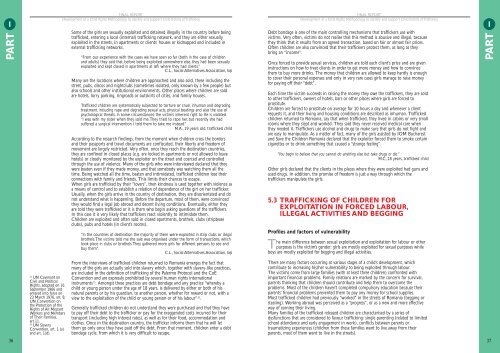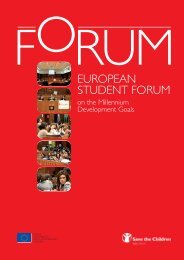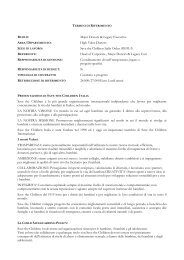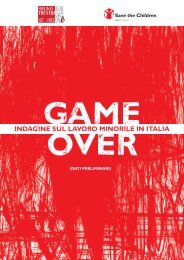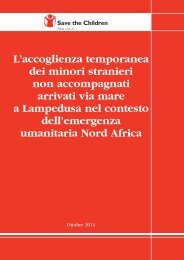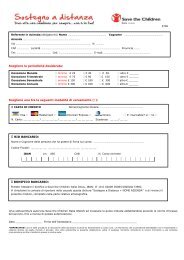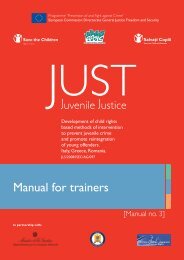IPART<strong>FINAL</strong> <strong>REPORT</strong>Development of a Child Rights Methodology to Identify and Support Child Victims of TraffickingSome of <strong>the</strong> girls are sexually exploited and detained illegally in <strong>the</strong> country before beingtrafficked, entering a local (internal) trafficking network, and <strong>the</strong>y are ei<strong>the</strong>r sexuallyexploited in <strong>the</strong> streets, in apartments or clients’ houses or kidnapped and included inexternal trafficking networks.“From our experience with <strong>the</strong> cases we have seen so far (both in <strong>the</strong> case of childrenand adults) <strong>the</strong>y said that, before being exploited somewhere else, <strong>the</strong>y had been sexuallyexploited and kept closed in apartments at Iafli where <strong>the</strong>y had clients.”C.L., Social Alternatives Association, IaşiMany are <strong>the</strong> locations where children are approached and also sold, <strong>the</strong>se including <strong>the</strong>street, pubs, discos and nightclubs (sometimes isolated, only known by a few people) butalso schools and o<strong>the</strong>r institutional environments. O<strong>the</strong>r places where children are soldare hotels, lorry parking, ringroads or outskirts of cities, and family houses.Trafficked children are systematically subjected to torture or cruel, inhuman and degradingtreatment, including rape and degrading sexual acts, physical beatings and also <strong>the</strong> use ofpsychological threats. In some circumstances, <strong>the</strong> victim’s inherent right to life is violated.“I was with my sister when <strong>the</strong>y sold me.They tried to rape her, but recently she hadsuffered a surgical intervention. I told <strong>the</strong>m to take me instead.”M.A., 19 years old, trafficked childAccording to <strong>the</strong> research findings, from <strong>the</strong> moment when children cross <strong>the</strong> bordersand <strong>the</strong>ir passports and travel documents are confiscated, <strong>the</strong>ir liberty and freedom ofmovement are largely restricted. Very often, once <strong>the</strong>y reach <strong>the</strong> destination countries,<strong>the</strong>y are confined in closed places (e.g. are locked in apartments or not allowed to leavehotels) or closely monitored by <strong>the</strong> exploiter on <strong>the</strong> street and coerced and controlledthrough <strong>the</strong> use of violence. Many of <strong>the</strong> girls who were interviewed declared that <strong>the</strong>ywere beaten even if <strong>the</strong>y made money, and that somebody was watching <strong>the</strong>m all <strong>the</strong>time. Being watched all <strong>the</strong> time, beaten and intimidated, trafficked children lose <strong>the</strong>irconnections with family and friends. This limits <strong>the</strong>ir chances to escape.When girls are trafficked by <strong>the</strong>ir “lovers”, <strong>the</strong>n kindness is used toge<strong>the</strong>r with violence asa means of control and to establish a relation of dependence of <strong>the</strong> girl on her trafficker.Usually, when <strong>the</strong> girls arrive in <strong>the</strong> country of destination, <strong>the</strong>y are disorientated and donot understand what is happening. Before <strong>the</strong> departure, most of <strong>the</strong>m, were convinced<strong>the</strong>y would find a legal job abroad and decent living conditions. Eventually, ei<strong>the</strong>r <strong>the</strong>yare told <strong>the</strong>y were trafficked or it is <strong>the</strong>m who begin asking questions of <strong>the</strong> traffickers.In this case it is very likely that traffickers react violently to intimidate <strong>the</strong>m.<strong>Children</strong> are exploited and often sold in closed apartments, bro<strong>the</strong>ls, clubs (stripteaseclubs), pubs and hotels (in client’s rooms).“In <strong>the</strong> countries of destination <strong>the</strong> majority of <strong>the</strong>m were exploited in strip clubs or illegalbro<strong>the</strong>ls.The victims told me <strong>the</strong> sale was organised under <strong>the</strong> form of transactions, whichtook place in clubs or bro<strong>the</strong>ls.They ga<strong>the</strong>red more girls for different persons to see andbuy <strong>the</strong>m”.C.L., Social Alternatives Association, Iaşi<strong>FINAL</strong> <strong>REPORT</strong>Development of a Child Rights Methodology to Identify and Support Child Victims of TraffickingDebt bondage is one of <strong>the</strong> main controlling mechanisms that traffickers use withvictims. Very often, victims do not realise that this method is abusive and illegal, because<strong>the</strong>y think that it results from an agreed transaction, based on fair or almost fair prices.Often children are also convinced that <strong>the</strong>ir traffickers protect <strong>the</strong>m, as long as <strong>the</strong>ybring an “income”.Once forced to provide sexual services, children are told each client’s price and are giveninstructions on how to treat clients in order to get more money and how to convince<strong>the</strong>m to buy more drinks. The money that children are allowed to keep hardly is enoughto cover <strong>the</strong>ir personal expenses and only in very rare cases girls manage to raise moneyfor paying off <strong>the</strong>ir “debt”.Each time <strong>the</strong> victim succeeds in raising <strong>the</strong> money <strong>the</strong>y owe <strong>the</strong> traffickers, <strong>the</strong>y are soldto o<strong>the</strong>r traffickers, owners of hotels, bars or o<strong>the</strong>r places where girls are forced toprostitute.<strong>Children</strong> are forced to prostitute on average for 10 hours a day and whenever a clientrequests it, and <strong>the</strong>ir living and housing conditions are described as inhuman. Traffickedchildren returned to Romania, say that when trafficked, <strong>the</strong>y lived in cabins or very smallrooms where <strong>the</strong>y slept and worked. They said <strong>the</strong>y never received medical care when<strong>the</strong>y needed it. Traffickers use alcohol and drugs to make sure that girls do not fight andare easy to manipulate. As a matter of fact, many of <strong>the</strong> girls assisted by IOM Bucharestand <strong>Save</strong> <strong>the</strong> <strong>Children</strong> Romania declared that <strong>the</strong> exploiter forced <strong>the</strong>m to smoke certaincigarettes or to drink something that caused a “strange feeling”.“You begin to believe that you cannot do anything else but take drugs or die.”M.C.,18 years, trafficked childO<strong>the</strong>r girls declared that <strong>the</strong> clients in <strong>the</strong> places where <strong>the</strong>y were exploited had guns andused drugs. In addition, <strong>the</strong> promise of freedom is just a way through which <strong>the</strong>traffickers manipulate <strong>the</strong> girls.5.3 TRAFFICKING OF CHILDREN FOREXPLOITATION IN FORCED LABOUR,ILLEGAL ACTIVITIES AND BEGGINGProfiles and factors of vulnerabilityThe main difference between sexual exploitation and exploitation for labour or o<strong>the</strong>rpurposes is <strong>the</strong> victim’s gender: girls are mostly exploited for sexual purposes whileboys are mostly exploited for begging and illegal activities.IPART25UN Covenant onCivil and PoliticalRights, adopted on 16September 1966 andentered into force on23 March 1976, art. 8;UN Convention on<strong>the</strong> Protection of <strong>the</strong>Rights of All MigrantWorkers and Membersof Their Families,art.11.26UN SlaveryConvention, art. 1 (a)and art. 1(d).From <strong>the</strong> interviews of trafficked children returned to Romania emerges <strong>the</strong> fact thatmany of <strong>the</strong> girls are actually sold into slavery which, toge<strong>the</strong>r with slavery-like practices,are included in <strong>the</strong> definition of trafficking of <strong>the</strong> Palermo Protocol and <strong>the</strong> CoEConvention and are expressly prohibited by several human rights internationalinstruments 25 . Amongst <strong>the</strong>se practices are debt bondage and any practice “whereby achild or young person under <strong>the</strong> age of 18 years, is delivered by ei<strong>the</strong>r or both of hisnatural parents or by his guardian, to ano<strong>the</strong>r person, whe<strong>the</strong>r for reward or not, with aview to <strong>the</strong> exploitation of <strong>the</strong> child or young person or of his labour” 26 .Generally trafficked children do not understand <strong>the</strong>y were purchased and that <strong>the</strong>y haveto pay off <strong>the</strong>ir debt to <strong>the</strong> trafficker or pay for <strong>the</strong> exaggerated costs incurred for <strong>the</strong>irtransport (including high interest rates), as well as for <strong>the</strong>ir food, accommodation andclo<strong>the</strong>s. Once in <strong>the</strong> destination country, <strong>the</strong> trafficker informs <strong>the</strong>m that he will let<strong>the</strong>m go only once <strong>the</strong>y have paid off <strong>the</strong> debt. From that moment, children enter a debtbondage cycle, from which it is very difficult to escape.There are many factors occurring at various stages of a child’s development, whichcontribute to increasing his/her vulnerability to being exploited through labour.The victims come from large families (with at least three children) confronted withimportant financial problems. Family relations are marked by <strong>the</strong> concern for survival,parents thinking that children should contribute and help <strong>the</strong>m to overcome <strong>the</strong>problems. Most of <strong>the</strong> children haven’t completed compulsory education because <strong>the</strong>irparents’ financial problems prevented <strong>the</strong>m to pay any money for school supplies.Most trafficked children had previously “worked” in <strong>the</strong> streets of Romania (begging orstealing). Working abroad was perceived as a “progress”, or as a new and more effectiveway of earning <strong>the</strong>ir living.Many families of <strong>the</strong> trafficked released children are characterised by a series ofdysfunctions that are considered to favour trafficking: single parenting (related to limitedschool attendance and early engagement in work), conflicts between parents ortraumatizing experiences (children from <strong>the</strong>se families want to live away from <strong>the</strong>irparents, most of <strong>the</strong>m want to live in <strong>the</strong> streets).3637
IPART27Stativă Ecaterina,IOMC, “BaselineSurvey on Rural ChildLabour in Five SelectedCounties”, Bucharest,2005.28Cace Sorin,ECHOSOCFoundation, “RomaWorking <strong>Children</strong> and<strong>the</strong>ir Families-SocioculturalCharacteristicsand LivingConditions”, RO MediaPublishing, Bucharest,2005.<strong>FINAL</strong> <strong>REPORT</strong>Development of a Child Rights Methodology to Identify and Support Child Victims of TraffickingTaking into account <strong>the</strong> environment where <strong>the</strong> children involved in labour exploitationcan be found, one can distinguish:• <strong>Children</strong> who work in <strong>the</strong> streetThe most frequent activities of children that work in <strong>the</strong> streets are: begging, loadingand unloading merchandise, washing windshields or cars in parking lots, sellingflowers or newspapers and collecting wastes.• <strong>Children</strong> who work in <strong>the</strong> rural areasThe daily tasks assigned by children’s parents in rural areas include cleaning up <strong>the</strong>house, cooking, feeding <strong>the</strong> animals, various agricultural works, taking care of youngersiblings, chopping wood etc. Some children work for a “local employer”. 27• Roma working childrenThe children work around <strong>the</strong> household or participate in agricultural activitiestoge<strong>the</strong>r with <strong>the</strong>ir parents, production or sale of different goods, collecting recyclablematerials, working in markets/warehouses, construction or in <strong>the</strong> street. Workinghours range between 4-10 hours a day and <strong>the</strong> children’s contribution to <strong>the</strong> family’sincome is usually already a tradition. 28One can also identify locations where trafficked children are very likely to be found.These are:• urban areas: streets; railway stations; central areas; subway stations;• rural areas: isolated villages; farms; mountain areas, where animal husbandry is practiced.Methods of recruitment, transport and trafficking routesIn <strong>the</strong> case of children trafficked for forced labour, including begging and illegalactivities, all <strong>the</strong> recruiters are Romanian nationals and are not necessarily part of anetwork that extends to <strong>the</strong> territory of <strong>the</strong> destination country. According to <strong>the</strong>research findings, <strong>the</strong>re are cases where victims were reportedly turned over to a networkin Romania or in <strong>the</strong> destination country.<strong>Children</strong> are mainly approached on <strong>the</strong> street, at railway and subway stations and incentral areas in urban settings. O<strong>the</strong>rwise, <strong>the</strong>y are approached in rural areas, in isolatedvillages and farms or in mountain areas, where animal husbandry is practiced.Most frequently, children are recruited by <strong>the</strong> family’s acquaintances or friends, with <strong>the</strong>consent of <strong>the</strong> family. It is very common that recruiters initially enter <strong>the</strong> family’s circleof friends with <strong>the</strong> specific purpose of recruiting children. Once <strong>the</strong>y get to know <strong>the</strong>family <strong>the</strong>y usually disclose <strong>the</strong>ir intentions and convince <strong>the</strong> parents or adultsresponsible for <strong>the</strong> children that working abroad gives better opportunities to <strong>the</strong> childand <strong>the</strong> family. In some cases one of <strong>the</strong> parents (usually <strong>the</strong> fa<strong>the</strong>r) accompanies <strong>the</strong>child to <strong>the</strong> country of destination. If this happens, it is very likely that <strong>the</strong> adultpreviously travelled abroad and is familiar with <strong>the</strong> itinerary and border crossing. In thissituation, adults do not fully understand that <strong>the</strong> child will be exploited and ra<strong>the</strong>rconsider <strong>the</strong>y will find legal employment. In o<strong>the</strong>r circumstances, parents sell <strong>the</strong>irchildren even though <strong>the</strong>y know about exploitative purpose, in which case <strong>the</strong> head of atrafficking network may send part of <strong>the</strong> child’s earnings to <strong>the</strong> family.Whatever <strong>the</strong> circumstances, recruiters usually offer <strong>the</strong> family mobile phones, clo<strong>the</strong>s, orjewellery already before <strong>the</strong> departure to influence <strong>the</strong>ir decision.Different is <strong>the</strong> situation where recruiters approach <strong>the</strong> victims <strong>the</strong>mselves. In this case<strong>the</strong>y offer <strong>the</strong> children good jobs abroad and children accept to go with <strong>the</strong> traffickerbecause <strong>the</strong>y hope to have a better life. In this case, traffickers do not offer any money orgoods before leaving. The dynamic is <strong>the</strong> same as <strong>the</strong> one described for childrentrafficked for sexual exploitation.Ano<strong>the</strong>r case is that of teenagers who decide to leave on <strong>the</strong>ir own under <strong>the</strong> influence of<strong>the</strong> gangs <strong>the</strong>y are part of. They are introduced to adults who facilitate <strong>the</strong>ir departure oreven accompany <strong>the</strong>m to <strong>the</strong> destination country (<strong>the</strong> preferred country in this casebeing Italy). In this situation, <strong>the</strong> teenagers become vulnerable to trafficking once <strong>the</strong>y<strong>FINAL</strong> <strong>REPORT</strong>Development of a Child Rights Methodology to Identify and Support Child Victims of Traffickingreach <strong>the</strong> destination country and are not victims when <strong>the</strong>y leave <strong>the</strong> country of origin.Ra<strong>the</strong>r than trafficking, <strong>the</strong> situation is that of smuggling.In <strong>the</strong> case of trafficking for exploitation in forced labour, both in <strong>the</strong> case ofinvolvement of <strong>the</strong> family or when children travel alone with <strong>the</strong>ir trafficker or recruiter,<strong>the</strong> most common means of transportation used to reach <strong>the</strong> destination countries arebuses of specialised travel agencies and trains. Parents or recruiters only use certaincompanies recommended by those who had successfully managed to get to <strong>the</strong>destination country. Drivers usually are well experienced and provide advice or tips about<strong>the</strong> possible obstacles or risks involved in crossing <strong>the</strong> border.In many cases, recruiters use several different transportation companies on <strong>the</strong>ir way to <strong>the</strong>destination country. They prefer to travel first to one of <strong>the</strong> capitals of a neighbouringcountry (e.g. Budapest, Belgrade, Sofia) and <strong>the</strong>n use a bus from a local transportationcompany. This is done to avoid strict inspections of tourist buses coming from Romania.As happens in <strong>the</strong> case of trafficking for sexual exploitation, illegal crossing of <strong>the</strong>Romanian borders to neighbouring countries is usually done with <strong>the</strong> help of“specialised” guides. Thus, <strong>the</strong> guides, recruiters and transporters are some of <strong>the</strong> mostimportant intermediaries for traffickers in <strong>the</strong> destination country.Living conditions and forms of exploitationBefore leaving <strong>the</strong> country, trafficked children already used to work in <strong>the</strong> in street fora long time, sometimes more than eight hours per day and in very difficultconditions (unbearable heat or very low temperatures). Many children suffered skindiseases, tuberculosis, and hepatitis as a consequence of <strong>the</strong> unhygienic conditions <strong>the</strong>yare used to living in. Most of <strong>the</strong>m were also involved in illegal activities such as drugdealing. The number of school drop outs among trafficked children seems to be veryhigh. In some cases, although not as frequently as for child victims of trafficking forsexual exploitation, children were physically abused.As far as Roma children are concerned, <strong>the</strong>ir involvement in work in order to contributeto <strong>the</strong> family income is a tradition. <strong>Children</strong> work within <strong>the</strong> household (cleaning,taking care of younger siblings) and/or participate toge<strong>the</strong>r with <strong>the</strong>ir parents inagricultural activities, production or sale of different goods, collection of recyclablematerials, working in squares/warehouses, in construction or on <strong>the</strong> street (begging orwashing windscreens of cars). Working hours range between 4-10 hours a day. There arecases where children were exploited by <strong>the</strong>ir parents or relatives before being trafficked:<strong>the</strong>ir working conditions were intolerable and <strong>the</strong> risk of accidents, sickness or of beinginvolved in illegal activities, such as drug dealing, very high.Trafficked children generally work in <strong>the</strong> streets, which exposes <strong>the</strong>m to <strong>the</strong> risks of streetlife, and are mainly exploited in illegal activities, such as petty crimes, and begging but<strong>the</strong>re are also cases of children forced to work in agriculture, picking fruits or vegetables(Germany, Spain, Austria) and selling flowers. <strong>Children</strong> are also exploited through labourin constructions, (<strong>the</strong> Czech Republic).Trafficked children interviewed reported that <strong>the</strong>y faced harsh living conditions uponreaching <strong>the</strong> destination countries. Their housing conditions were appalling: verycrowded shelters with adults, tents, trailers, insalubrious or deserted houses andbasements. They were not given proper food and didn’t have enough rest time. Provisionor non-provision of food is a reward for <strong>the</strong>ir efficiency in collecting money or apunishment in <strong>the</strong> event <strong>the</strong>y are not successful. Violence is also commonly used tocombat children’s resistance or to increase <strong>the</strong>ir efficiency and dependency.<strong>Children</strong> told <strong>the</strong> researchers that <strong>the</strong>y were forced to earn a certain amount of moneyper day, o<strong>the</strong>rwise <strong>the</strong>ir traffickers used physical violence as a means of persuasion andintimidation. Even <strong>the</strong> children exploited by <strong>the</strong>ir parents or relatives admitted that <strong>the</strong>ywere afraid of <strong>the</strong> beatings at <strong>the</strong> end of <strong>the</strong> day. The money <strong>the</strong>y earned was given to <strong>the</strong>traffickers, but some children did not even know <strong>the</strong> value of money, ei<strong>the</strong>r because of<strong>the</strong>ir younger age or <strong>the</strong>ir poor level of education.They also said that being controlled by <strong>the</strong> traffickers, <strong>the</strong>y could not play or makefriends, nor could <strong>the</strong>y ask for <strong>the</strong> support of, and <strong>the</strong>reby benefit from, <strong>the</strong> socialservices provided in <strong>the</strong> destination countries.IPART3839


